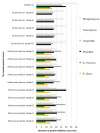Biologically Active Preparations from the Leaves of Wild Plant Species of the Genus Rubus
- PMID: 36080251
- PMCID: PMC9457741
- DOI: 10.3390/molecules27175486
Biologically Active Preparations from the Leaves of Wild Plant Species of the Genus Rubus
Abstract
The plants of the genus Rubus (R.) are applied as antiseptic agents in the treatment of skin diseases. Despite the great interest in plants of this genus, there are few reports on the antioxidant and biological activities of preparations obtained from the leaves of these plants. Therefore, we decided to evaluate the antioxidant activity of preparations from leaves of wild plant species of the genus Rubus using the frequently applied DPPH, ABTS, and FRAP methods, as well as to determine the total polyphenol content using the Folin−Ciocalteau method and perform qualitative evaluation by gas chromatography−mass spectrometry (GC-MS). The bactericidal and fungicidal activities of the obtained preparations were evaluated by applying laboratory tests: using the disc and the well methods based on the standards EN 13697:2019, EN 13697:2015, and EN 1500:2013. Microbiological tests of the plant preparations against bacteria, fungi, and yeasts isolated from the environment and against reference strains were performed. Moreover, antimicrobial testing of antibiotics against the tested strains was performed for comparison. The n-octanol/water partition coefficient of the obtained preparations was determined by the shake-flask method to determine their lipophilicity. According to the results, a high content of polyphenols and other antioxidant and biologically active compounds can be thought of as the parameter responsible for the effective activity of plant preparations obtained from wild plant species of the genus Rubus. The methods for determining bactericidal and fungicidal activity clearly demonstrates that preparations with reduced ethanol content exhibit bactericidal and fungicidal activity on surfaces. Testing of hand disinfection by means of rubbing with the preparations confirmed their antimicrobial activity against Escherichia coli K12 NCTC 10538. The obtained results show that the tested preparations exhibit on average two times lower activity against the reference bacterial strains than comparable antibiotics. The preparations obtained from the leaves of R. idaeus L. and R. fruticosus L. could complement classical antibiotics. While environmental bacteria showed a similar response to the preparations and antibiotics, their sensitivity was about one-third less than that of the reference strains. Our studies have shown that the obtained preparations are highly hydrophilic (logP < 0). Thus, these preparations can only be used in lipid bilayers in the aqueous core of liposomes, not in the lipid envelope.
Keywords: antimicrobial activity; antioxidative potential; bioactive compounds; biologically active preparations; leaves of Rubus fruticosus L.; leaves of Rubus idaeus L..
Conflict of interest statement
The authors declare no conflict of interest.
Figures





Similar articles
-
Polyphenolic Characterization, Antioxidant, Antihyaluronidase and Antimicrobial Activity of Young Leaves and Stem Extracts from Rubus caesius L.Molecules. 2022 Sep 21;27(19):6181. doi: 10.3390/molecules27196181. Molecules. 2022. PMID: 36234716 Free PMC article.
-
[Comparison of the antioxidant properties of selected parts of raspberry (Rubus idaeus) and blackberry (Rubus fruticosus)].Pomeranian J Life Sci. 2016;62(4):52-9. Pomeranian J Life Sci. 2016. PMID: 29537790 Polish.
-
Chemical composition and biological activity of Rubus idaeus shoots--a traditional herbal remedy of Eastern Europe.BMC Complement Altern Med. 2014 Dec 12;14:480. doi: 10.1186/1472-6882-14-480. BMC Complement Altern Med. 2014. PMID: 25496130 Free PMC article.
-
Phenolic Composition, Mineral Content, and Beneficial Bioactivities of Leaf Extracts from Black Currant (Ribes nigrum L.), Raspberry (Rubus idaeus), and Aronia (Aronia melanocarpa).Nutrients. 2020 Feb 12;12(2):463. doi: 10.3390/nu12020463. Nutrients. 2020. PMID: 32059465 Free PMC article. Review.
-
Antibacterial, antifungal and antioxidant activity of total polyphenols of Withania frutescens.L.Bioorg Chem. 2019 Dec;93:103337. doi: 10.1016/j.bioorg.2019.103337. Epub 2019 Oct 8. Bioorg Chem. 2019. PMID: 31627061 Review.
Cited by
-
Correlation between Antimicrobial Activity Values and Total Phenolic Content/Antioxidant Activity in Rubus idaeus L.Plants (Basel). 2024 Feb 11;13(4):504. doi: 10.3390/plants13040504. Plants (Basel). 2024. PMID: 38498473 Free PMC article.
References
-
- Zhang L., Cao H., Li L., Zhao W., Zhang F. Oral and External Intervention on the Crosstalk between Microbial Barrier and Skin via Foodborne Functional Component. J. Funct. Foods. 2022;92:105075. doi: 10.1016/j.jff.2022.105075. - DOI
-
- Milani C., Duranti S., Bottacini F., Casey E., Turroni F., Mahony J., Belzer C., Delgado Palacio S., Arboleya Montes S., Mancabelli L., et al. The First Microbial Colonizers of the Human Gut: Composition, Activities, and Health Implications of the Infant Gut Microbiota. Microbiol. Mol. Biol. Rev. 2017;81:e00036-17. doi: 10.1128/MMBR.00036-17. - DOI - PMC - PubMed
-
- Barbulova A., Apone F., Colucci G. Plant Cell Cultures as Source of Cosmetic Active Ingredients. Cosmetics. 2014;1:94–104. doi: 10.3390/cosmetics1020094. - DOI
MeSH terms
Substances
LinkOut - more resources
Full Text Sources
Molecular Biology Databases
Research Materials
Miscellaneous

